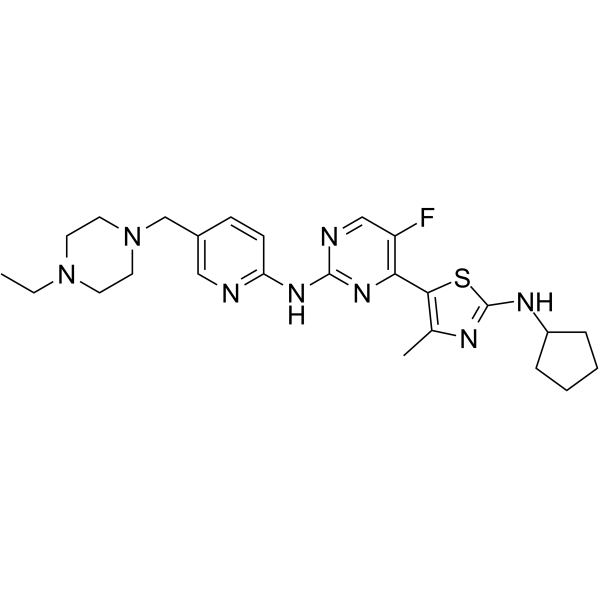Ulecaciclib
Modify Date: 2024-08-13 00:34:01

Ulecaciclib structure
|
Common Name | Ulecaciclib | ||
|---|---|---|---|---|
| CAS Number | 2075750-05-7 | Molecular Weight | 496.65 | |
| Density | N/A | Boiling Point | N/A | |
| Molecular Formula | C25H33FN8S | Melting Point | N/A | |
| MSDS | N/A | Flash Point | N/A | |
Use of UlecaciclibUlecaciclib is an orally activitive inhibitor of cyclin-dependent kinase (CDK), with Ki values of 0.62 μM (CDK2/Cyclin A), 0.2 nM (CDK4/Cyclin D1), 3 nM (CDK6/Cyclin D3), and 0.63 μM (CDK7/Cyclin H), respectively. Ulecaciclib can cross blood brain barrier and has good pharmacokinetic characteristics[1][2][3]. |
| Name | Ulecaciclib |
|---|
| Description | Ulecaciclib is an orally activitive inhibitor of cyclin-dependent kinase (CDK), with Ki values of 0.62 μM (CDK2/Cyclin A), 0.2 nM (CDK4/Cyclin D1), 3 nM (CDK6/Cyclin D3), and 0.63 μM (CDK7/Cyclin H), respectively. Ulecaciclib can cross blood brain barrier and has good pharmacokinetic characteristics[1][2][3]. |
|---|---|
| Related Catalog | |
| Target |
cdk2/cyclin A:0.62 μM (Ki) Cdk4/cyclin D1:0.2 nM (Ki) cdk6/cyclin D3:3 nM (Ki) cdk7-cyclin H:0.63 μM (Ki) |
| In Vitro | Ulecaciclib (compound 2) (40 min) displays inhibitory effect on CDK kinase with Ki values of 0.62 μM (CDK2/A), 0.2 nM (CDK4/Cyclin D1), 3 nM (CDK6/Cyclin D3), 0.63 μM (CDK7/H), respectively[2]. Ulecaciclib (72 h) exhibits a strong antiproliferative activity against leukemia cells with a growth inhibition GI50 value of 10 nM[2]. Ulecaciclib (72 h) inhibits tumor growth with GI50s range from 0.04-5.09 μM and inhibits Ovarian A2780 with an GI50 value of 40 nM, in particularly[2]. Cell Viability Assay[2] Cell Line: U87, U251, T98G (mycoplasma-free); and MB453, Colo205, H460, A2780, PANC1, LNC, M229 Concentration: 0-10 μM Incubation Time: 72 hours Result: Inhibited cancer cells growth with GI50s of 2.17 μM (U87), 5.09 μM (U251), 4.18 μM (T98G), 0.62 μM (MB453), 1.55 μM (Colo205), 0.41 μM (H460), 0.04 μM (A2780), 1.21 μM (PANC1), 0.28 μM (LNC), 0.83 μM (M229). |
| In Vivo | Ulecaciclib (compound 2) (2 mg/kg for i.v.; 10 mg/kg for p.o.) demonstrates a significantly propensity to cross the blood brain barrier in mice, with the brain/plasma ratios are >1.2 (i.v.) or >0.7 (p.o.), respectively[2]. Ulecaciclib (200 mg/kg; p.o.; daily; 21 d) displays in vivo anti-tumour efficacy in mice[2]. Ulecaciclib (25 mg/kg; p.o.; daily; 10 d) demonstrates significant anti-tumour efficacy at lower doses in combination with TMZ (5 mg/kg; p.o.; 5 d/week; 2 weeks) in mice[2]. Ulecaciclib (compound A) (50 mg/kg; p.o.) shows an oral bioavailability of about 21.8%, and good pharmacokinetic profile with Tmax of 6.67 h and an half- of 8.34 h, while Cmax =643 ng/mL, AUC(0-24) =9543 ng•h/mL in male cynomolgus monkeys[3]. Pharmacokinetic of Ulecaciclib in cynomolgus monkeys[3] Route Dose (mg/kg) T1/2 (h) Tmax (h) Cmax (ng/mL) AUC(0-t) (h•ng/mL) AUC(0-∞) (h•ng/mL) Vd (L/kg) CL (mL/min/kg) MRT(0-t) (h) F (%) i.v. 5 6.53 / 447 4187 4560 9.79 19.4 6.64 / p.o. 50 8.34 6.67 643 9543 7305 / / 10.4 21.8 Animal Model: CDl nu/nu female mice (5-6 weeks old; injected with U87 GBM cells, s.c.)[2] Dosage: 200 mg/kg Administration: Oral gavage; daily; 21 days Result: Reduced tumour growth markedly without any overt toxicity. Animal Model: GBM orthotopic mouse xenograft models[2] Dosage: 120 mg/kg Administration: Oral gavage; daily for 2 days Result: Inhibited tumor growth on day 21 and increased life span ratio (ILS) of 154.8% for teated mice. ILS = (DaysT - DaysC)/DaysC, where DaysC = days survived by control group and DaysT = days survived by treatment group. |
| References |
| Molecular Formula | C25H33FN8S |
|---|---|
| Molecular Weight | 496.65 |